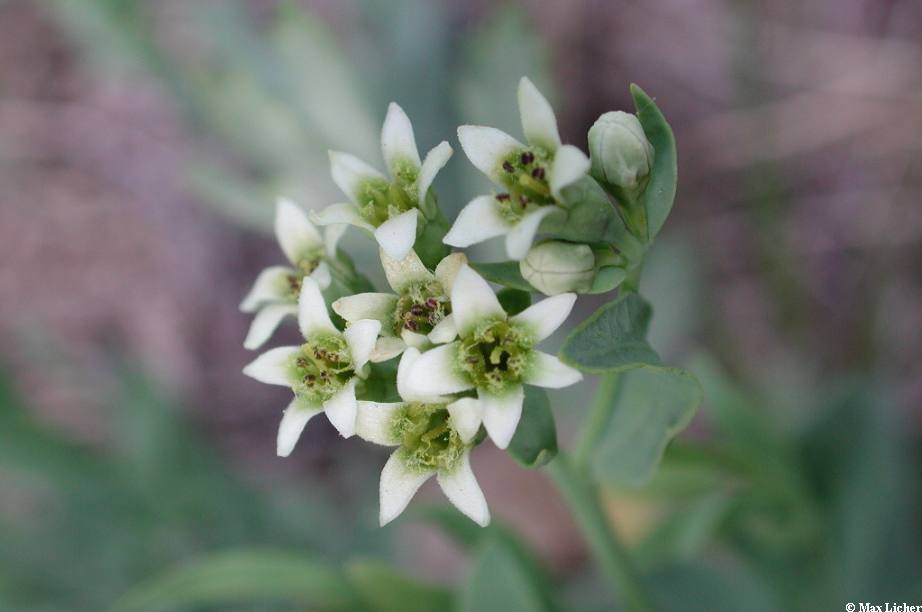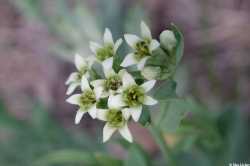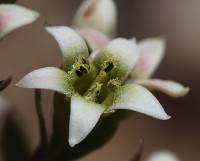PLANTS: Perennial, erect, glabrous, rhizomatous herbs or sub-shrubs 7-50 em tall, root-parasitic on a variety of angiosperms.
STEMS: striate, branching freely at base but sparingly above, 5-40(-45) em tall; rhizomes 1-5 mm thick; rhizome cortex (in ours) bluish when fresh, often blackish when dry.
LEAVES: alternate, narrowly linear-Ianceolate to ovate-oblong, entire, acute, firm, subsessile to short petiolate, 5-40(-60) mm long, 1-1O(-16)mm wide; base acute to attenuate; tip acute to obtuse.
INFLORESCENCE: of terminal and subterminal clusters of 3-6-flowered cymes, each subtended by a foliaceous bract.
FLOWERS: perfect, epigynous, 3-7 mm across; pedicels 0-4 mm long, each subtended by a bracteole; perianth rotate to turbinate or campanulate, the (3-)5(-7) lobes 3-4 mm long, white to pink or purplish, spreading to suberect, ciliolate, with long erect hairs below the middle of the inner surface which adhere to the anthers, the tube green persistent, usually shorter than the lobes; stamens 1 mm long, the anthers ovate, 0.4-0.7 mm long, opening by longitudinal slits; ovules (2-)3(-4); style filiform, 2-3 mm long; stigma capitate.
FRUIT: ovoid to subglobose drupes, smooth to slightly roughened, 4-8(-10) mm long, yellowish or brown at maturity; exocarp thinly fleshy or succulent; endocarp thin, hard, brittle.
SEEDS: globose. 2N=28.
NOTES: A monotypic genus with 4 subspp. (Greek come = hair + aner = man, alluding to hairs ofperianth lobes attached to anthers). Peihl, A. 1965. Mem. Torrey Bot. Club 22(1):1-97.
REFERENCES: Laferriere, Joseph E. 1994. Santalaceae. J. Ariz. - Nev. Acad. Sci. Volume 27(2), 240.
Fls perfect, epigynous; hypanthium well developed, lined with a nectary that is shallowly lobed at the summit alternate with the stamens; tep mostly 5, appearing as lobes on the hypanthium, each bearing a tuft of hairs behind and ±adherent to the stamen; ovary unilocular; placental column geniculate near midlength; stigma capitate; ovules mostly 3; fr a dry drupe, subglobose or with a short neck at the top, surmounted by the persistent sep; glabrous low perennial herbs, colonial by rhizomes, with rather small, alternate or scattered, subsessile or short-petiolate lvs and terminal cymose-paniculiform infls of small fls. 2, the other in Eur.
Gleason, Henry A. & Cronquist, Arthur J. 1991. Manual of vascular plants of northeastern United States and adjacent Canada. lxxv + 910 pp.
©The New York Botanical Garden. All rights reserved. Used by permission.





